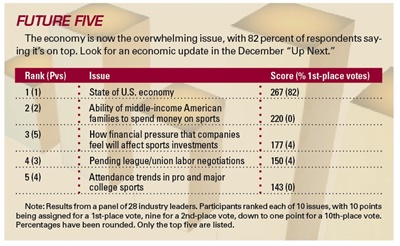Does it matter to the sports industry if sports fans prefer to watch games and events on TV or attend the games in person?
Does it matter if some sports have greater relative strength in the major media markets while others are proportionally stronger in the outlying markets?
At a time when most fans believe they can watch any game or event on the TV or Internet — not just the teams offered in their local area — does the actual location of the team or event even matter anymore?
If these questions don’t matter yet, they are likely to in the coming years because the sports fan landscape is shifting rather dramatically.
FORWARD THINKING With …
STEVE PHELPS
CHIEF MARKETING OFFICER, NASCAR
■ Like college sports, NASCAR is bigger in smaller markets than big markets. Is that good or bad for NASCAR?
“We believe NASCAR has greater additional strength in outlying markets because we are a true national sport. While team sports are identified by their cities and clustered in the bigger markets, we are not bound by geography. All our fans are focused on one national event each week, regardless of where the fan lives. This works well for our business partners as well because every event is valuable, and when a race comes to a market, that is important to them: It is a truly special national event.”
DAN DERIAN
VICE PRESIDENT OF RESEARCH AND STRATEGIC PLANNING, MAJOR LEAGUE BASEBALL
■ MLB is bigger in big markets, and more of your fans prefer to attend games (over watching on TV) than any other sport. Are these good or bad for MLB?
“Big-market strength is a good thing. We have 14 teams in the top 10 markets, and most of our teams are in the largest 25 markets. Our advantage in smaller markets comes from the over 150 Minor League Baseball teams exposing fans to the stars of the future. From your data, it’s clear we have a balance in viewing and attending as well, which is also great. Accessibility, in terms of the number of games and affordability of ticket prices, makes attending a more realistic option for most people in this economy. In a time of many changes in the fan experience, our balance is a real strength.”
For decades, the sports fan experience was centered on attending games and events. Even with growing television coverage, by 1998, The ESPN Sports Poll reported that the majority of fans for any major sport said they would rather attend the game than watch it on TV. Overall, 57 percent preferred attending, 37 percent preferred watching on TV. That was before HD, live sports on the Internet and the ability to catch nearly any game remotely if you tried hard enough.
Results from The ESPN Sports Poll in August 2011 show those findings have fully reversed, with 61 percent saying they would prefer to watch on TV and 35 percent saying they would rather attend the games in person. Today, there is no major sport where the fans would prefer attending over watching remotely.
Has this high-quality, broad access to nearly everything in sports translated into every major sport being truly national now, instead of just having strength where they have teams or events? No. In reality, some sports like NASCAR and college sports are relatively stronger in outlying markets. Others, like Major League Baseball and the NBA, are stronger in the biggest markets, and the NFL tips a bit toward the larger markets, but not by much. These differences are enough to make MLB a much closer No. 2 sport to the NFL in the largest markets. Both MLB and the NBA surpass college football in the 10 largest markets, and they are both bigger than college basketball in the top 25 markets. College football and basketball are stronger than MLB or the NBA in smaller markets (see chart).
Suppressed interest in college sports in major markets is even more interesting given there is a higher percentage of college graduates in the larger markets. Pro teams are defined most often by city, but always by geography, not by the composition of student body. As such, there is a less natural connection between a big city and any one school as compared to a city and its pro teams, even when there are two teams for a sport like baseball in Chicago. The South Siders follow the White Sox and the North Siders follow the Cubs.
The differences between NFL and MLB avid fans provided even more insight on the connection between remote access and attendance. The MLB experience seems to be more about attachment to a team, and the NFL has a stronger national following as a big event. MLB fans were more likely to say they preferred attendance over remote viewing (MLB 42
percent, NFL 29 percent prefer to attend). The favorite team of MLB fans was also more likely to be in the market where the fan lived (38 percent) than for NFL fans (28 percent). And in August, we asked NFL and MLB avid fans on The ESPN Sports Poll if they preferred following their local team, catching the biggest games, or a combination of the two. MLB fans were more likely to focus on their local team (44 percent) than were NFL fans (23 percent). For fans of both sports, those who prefer to watch on TV had a higher preference for catching the big game or event than those who prefer to attend games.
Then you have event-based sports like golf, tennis and racing. NASCAR, for example, has an even split of race locations by market size, with roughly half the races in or near a top-25 market and the rest in outlying markets. At a time when sports fan interests are less confined by geographic media offerings, sports that are not defined by geography — it’s not the Jacksonville Jimmie Johnsons — may have an opportunity to rewrite sports strategy.
Does it matter?
The quality and access to sports through technology will force us to reconsider at least two very important elements of the sports industry. First, we will need to rethink the strategy of team and event locations. For example, the fight for a new stadium will have different implications if going to games is less important than catching them remotely. And, second, will the development of the next generation of fans be harder or easier if the early experiences are more like watching TV as opposed to an outing with the family?
Rich Luker (rich@lukerco.com) is the founder of Luker on Trends and The ESPN Sports Poll.








